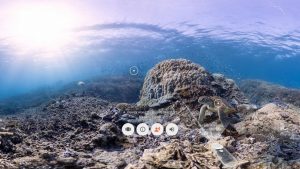Picture yourself standing at the edge of a cliff in the Wudang Mountains in China; the air is crisp and refreshing, the view is breathtaking, and you can finally experience what the author was describing in the novel, “Crouching Tiger, Hidden Dragon”. Wouldn’t it be ideal if you could drop everything and actually go there? Well, maybe that idealistic thought isn’t as far out of reach as it has been in the past.
With virtual reality tools that are emerging in the educational technology realm, the ability to visit and virtually be in any place in the world has been made possible. In ECI 201, we had the opportunity to visit the VR (Virtual Reality) labs here at NCSU. Before these classes, I wasn’t even aware that our university had VR labs or even VR equipment readily available to students and teachers. Subsequently, our two trips to the labs were extremely informative for me, and quite possibly my favorite classes of the entire semester.
On the first visit, we were told about all of the tools available to us to use and how to use them, and then we jumped right into using virtual and augmented reality. The first tools that we used were Google Expeditions; these produced more of an augmented reality than a virtual reality, but it was engaging, immersive, and exciting nonetheless. All that was needed was a smart phone with the Google Expeditions app on it and a viewer which can range from $7.00-$40.00. Through the app, our professor was able to take our whole class on a trip to a historic site in Hawaii where we could see, in 3D vision, everything around us as if we were standing there ourselves. The Expeditions app also comes with an abundance of places all over the world that you can choose to explore and lessons/facts about the places that you can visit.
app on it and a viewer which can range from $7.00-$40.00. Through the app, our professor was able to take our whole class on a trip to a historic site in Hawaii where we could see, in 3D vision, everything around us as if we were standing there ourselves. The Expeditions app also comes with an abundance of places all over the world that you can choose to explore and lessons/facts about the places that you can visit.
Immediately I understood how this tool could be used in the classroom. Of course, because it was augmented reality versus virtual reality, it wasn’t so realistic that I genuinely felt as though I was in Hawaii, but I was able to visualize the things that were being described, and I do feel as though it was much more memorable than looking at pictures in a textbook. I was fully engaged in and intrigued by the lesson, and because of that I can only imagine how an elementary schooler might feel with this technology. One of the biggest cons of virtual reality in education, in my opinion, is that it can be extremely expensive and not every school can afford it. However, with Google Expeditions and augmented reality, the cheapest viewers can be found around $7.00 which is extremely affordable. I especially like the Expeditions because of the way that they are specifically geared towards educational purposes with built-in lessons for students to interact with and enjoy. Generally, despite the lack of complete immersion, I definitely foresee myself using these in my future classroom even if I have to purchase the viewers myself and let my students use my phone one at a time; I think they would be an awesome addition to a geography lesson, or even a social studies lesson where we would have the opportunity to tour the White House while learning about U.S. legislation! I imagine my students would be as engaged and excited, if not more so, as I was and that is my ultimate goal as an educator.

I do hope, however, that the most expensive and immersive virtual reality tools will become much more affordable and accessible in the future because I see great potential for them in education. With virtual reality, students can do things like hold 3D human brains and hearts in their hands, enhancing their experience in science/anatomy class, they can visit planets in outer space, the white house, other countries, or release their creativity by drawing 3D creations in art class that are more engaging than drawing has ever been before.
When I used VR in NCSU’s VR lab, I was able to draw 3D pieces using whatever color I wanted, whatever brush I wanted, and I could draw it however close or far away from me as I cared to. I envision apps like this being especially intriguing to students who want to be architects one day or fashion designers and can practice building/creating things and outfits through virtual reality. Students will actually want to be in school!
This video from Viceland on youtube shows how some students feel when using augmented and virtual reality, and also discusses how it can impact education as a whole.
Virtual reality can also help students become more empathetic; I saw a video on class in which students used virtual reality to travel to a school in Syria and experience a bombing. They obviously didn’t get hurt, but they saw what other Syrians see and felt the vibrations/impact of the bombs around them. Many of these students immediately after said that they gained a new sense of awareness of the severity of the situation in Syria, and that they feel horrible for the students who have to experience that. Virtual reality gave them a sense of empathy that they never would have gained without having that opportunity.
For the video of these students, click here!!I just feel like virtual reality offers so many opportunities that I never had in school that I would have benefitted from so greatly, and I can’t wait to see how it develops over the years. Of course there will be problems with ensuring that students are only using VR for educational purposes in the classroom, but that comes with every new piece of technology being used. The biggest barrier, in my opinion, is prices and the digital divide between schools who can afford VR and schools who can’t. As much as I would love to give my students the best tools available, I also plan on working in a lower-income school when I first graduate (in 3 years), so that may not be an option for me. Hopefully, though, in the future, VR will be as accessible as other technologies are now. I want students who are visual and tactile learners (like me) to have opportunities to learn to the best of their abilities, and I want my students to travel to other countries, foster cultural awareness, talk to other students, and form empathy.
Pictures from Pixabay


Comments by oafrost